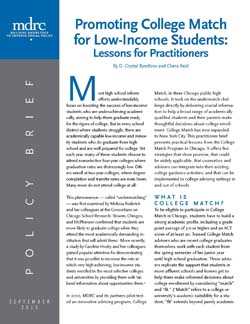Promoting College Match for Low-Income Students
Lessons for Practitioners

This brief has been updated to reflect changes in the FAFSA requirements that went into effect as of October 2016.
Most high school reform efforts understandably focus on boosting the success of low-income students who are underachieving academically, aiming to help them graduate ready for the rigors of college. But in every school district where students struggle, there are academically capable low-income and minority students who do graduate from high school and are well prepared for college. Yet each year, many of these students choose to attend nonselective four-year colleges where graduation rates are distressingly low. Others enroll at two-year colleges, where degree completion and transfer rates are even lower. Many more do not attend college at all.
This phenomenon — called “undermatching” — was first examined by Melissa Roderick and her colleagues at the Consortium on Chicago School Research. Bowen, Chingos, and McPherson confirmed that students are more likely to graduate college when they attend the most academically demanding institution that will admit them. More recently, a study by Caroline Hoxby and her colleagues gained popular attention for demonstrating that it was possible to increase the rate at which very high-achieving, low-income students enrolled in the most selective colleges and universities by providing them with tailored information about opportunities there.
In 2010, MDRC and its partners pilot-tested an innovative advising program, College Match, in three Chicago public high schools. It took on the undermatch challenge directly by delivering crucial information to help a broad range of academically qualified students and their parents make thoughtful decisions about college enrollment. College Match has now expanded to New York City. This practitioner brief presents practical lessons from the College Match Program in Chicago. It offers five strategies that show promise, that could be widely applicable, that counselors and advisers can integrate into their existing college guidance activities, and that can be implemented in college advising settings in and out of schools.







